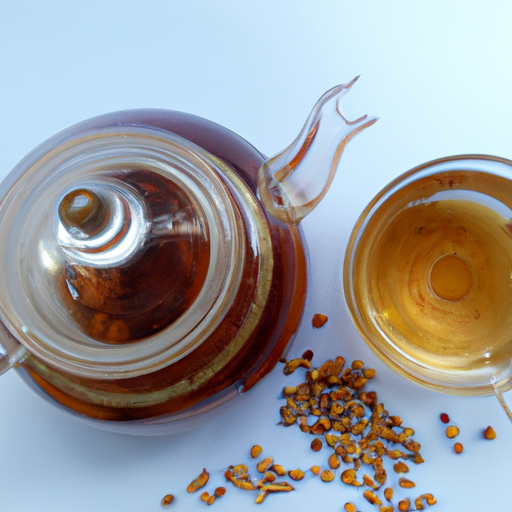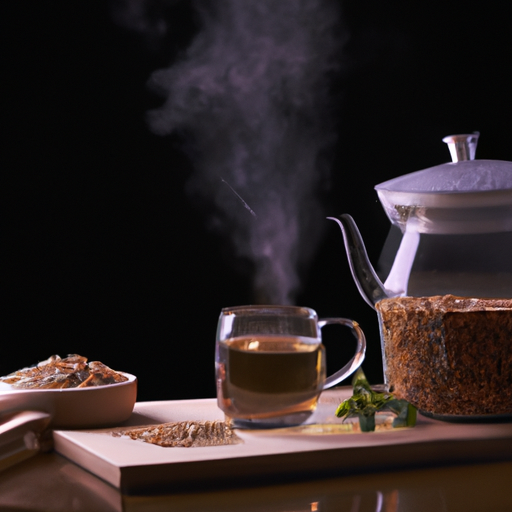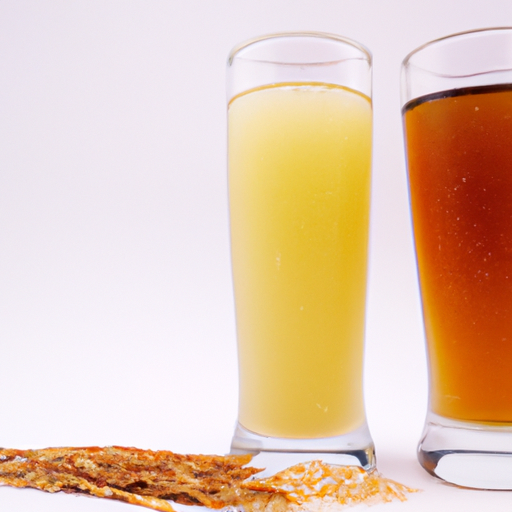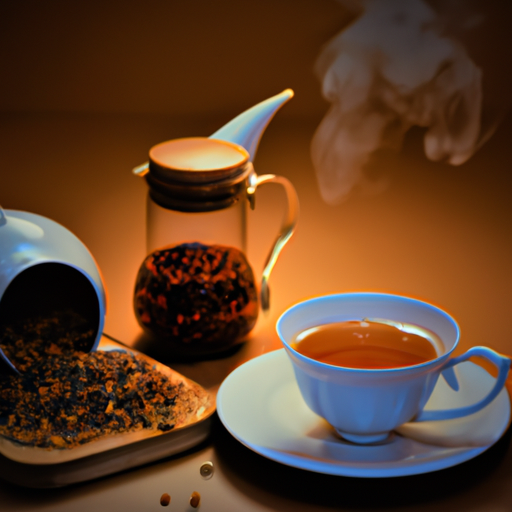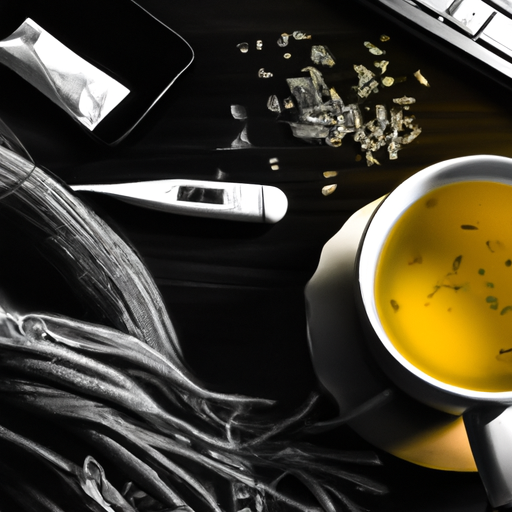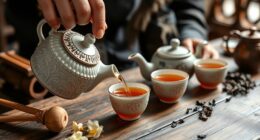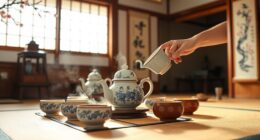My introduction to barley tea happened on a journey to Korea last year. It became a staple at each meal and was even available as a cool beverage in coffee shops. The tea’s nutty flavor with a hint of sweetness caught my interest, and discovering its wide range of health advantages came as a pleasant surprise.
Since then, I’ve been making my own barley tea at home and it has become a staple in my daily routine. In this article, I will share with you my recipe for making Korean-style barley tea. Not only is it easy to make, but it’s also a great way to incorporate a healthy beverage into your daily routine.
With just a few simple ingredients and tools, you can enjoy a delicious and soothing cup of barley tea anytime. So, let’s get started!
Key Takeaways
- Barley tea is a popular drink in Korean culture and is believed to improve overall health.
- Roasting barley is essential to enhance the flavor of the tea and give it a nutty aroma.
- Barley tea is a natural diuretic, caffeine-free, and a great source of antioxidants.
- Glass bottles are recommended over plastic bottles for serving and storing barley tea due to potential harmful chemicals in plastic.
Benefits of Drinking Barley Tea
You’ll love how drinking barley tea can improve your health and make you feel refreshed! This tea has been known for its health benefits for centuries, with its origins in ancient Korea. It’s a popular drink in Korean culture and is enjoyed by people of all ages.
One of the most significant benefits of drinking barley tea is its nutritional value. It’s packed with vitamins and minerals such as niacin, vitamin B6, iron, potassium, and magnesium. Drinking barley tea regularly can help improve your overall health.
It’s known to be a natural diuretic, which means it helps flush out toxins from your body. It’s also known to help reduce inflammation and may help with digestion. The tea is also caffeine-free, which makes it a great alternative to traditional caffeinated beverages. Plus, it’s a great way to stay hydrated throughout the day.
To make this tea, you’ll need a few simple ingredients and tools. But first, let’s talk about the benefits of drinking this delicious tea! The next time you’re looking for a refreshing and healthy beverage, consider making a cup of barley tea. You’ll love how it makes you feel, and your body will thank you for all the nutrients it provides.
Ingredients and Tools Needed
To prepare this traditional Korean beverage, you’ll need a few simple ingredients and tools. For starters, you’ll need barley, water, and a teapot or pot. You can buy barley at most grocery stores or online. You can choose to use either hulled or unhulled barley, but the former is easier to roast because it doesn’t have the tough outer layer that the latter has.
Roasting techniques are important when making barley tea. Roasting helps to enhance the flavor of the tea and also gives it a nutty aroma. To roast barley, you can use an oven or a skillet. If using an oven, preheat it to 350°F and spread the barley on a baking sheet. Roast for 10-15 minutes, stirring occasionally. If using a skillet, heat it over medium-high heat and stir frequently until the barley turns golden brown.
Aside from its delicious taste, barley tea has many health benefits. It is believed to help with digestion, lower cholesterol levels, and improve blood circulation. It is also a great source of antioxidants and can help to boost your immune system.
With these ingredients and tools in hand, and knowing the importance of roasting techniques and the health benefits, let’s move on to the steps to roasting barley.
Steps to Roasting Barley
Roasting barley is essential in bringing out its nutty aroma and enhancing its flavor. There are two techniques to choose from when roasting barley: using an oven or a skillet.
To start, preheat your oven to 350 degrees Fahrenheit. Spread the barley evenly on a baking sheet and place it in the oven. Roast the barley for about 20 minutes, stirring occasionally, until it turns golden brown.
If you prefer to use a skillet, heat it up over medium-high heat. Add the barley and stir constantly for about 5 minutes until it turns golden brown. Be sure to keep a close eye on the barley to prevent it from burning.
Once the barley is roasted, let it cool down to room temperature before using it to brew your tea. By roasting the barley, you’re enhancing its flavor profile by adding a nutty and toasty note to it. This is what gives Korean barley tea its unique taste.
Now that you’ve roasted your barley, you’re ready to move on to the next step, brewing the tea.
Brewing Barley Tea
After roasting, the barley is ready for infusion to create a flavorful and aromatic beverage. Brewing barley tea is a straightforward process that requires minimal effort and equipment. Here’s how I make a perfect cup of Korean barley tea:
-
Boil water: Start by boiling water in a pot or kettle. The amount of water you need depends on how many cups of tea you want to make. For one cup, you’ll need about 1 1/2 cups of water.
-
Add barley: Once the water comes to a boil, add the roasted barley to the pot. You can use a tea strainer or a muslin cloth to contain the barley while it infuses. Let the barley steep for about 5-10 minutes, depending on how strong you want the tea to be.
-
Serve and enjoy: After the tea has steeped, remove the barley and pour the tea into a cup. You can add honey or sugar to taste. Barley tea can be served hot or cold, depending on your preference.
Barley tea is a versatile beverage that pairs well with a variety of foods. It’s a popular drink in Korean cuisine and is often served with meals. Some of my favorite pairing suggestions include rice dishes, grilled meats, and spicy dishes.
Barley tea has a slightly nutty and earthy flavor that complements the flavors of savory dishes. In the next section, I’ll discuss how you can add flavor to your barley tea by using different ingredients. By experimenting with different flavors, you can create a unique and delicious beverage that suits your taste buds.
Adding Flavor to Barley Tea
If you’re looking to spice up your cup of barley tea, try adding some unexpected ingredients like fresh herbs or fruit to create a unique and refreshing beverage. Adding flavors to barley tea is a great way to experiment with new taste combinations and create a beverage that is tailored to your taste buds. Some popular flavor combinations include adding mint or lemon for a refreshing twist, or adding ginger or cinnamon for a more warming flavor.
To add flavor to barley tea, you can either add the ingredients during the brewing process or after the tea has been brewed. For example, if you want to add a minty flavor to your tea, you can add some fresh mint leaves to the pot during the brewing process. Alternatively, you can add some crushed mint leaves to the tea after it has been brewed. Different brewing techniques and flavor combinations can create a wide range of taste profiles, so don’t be afraid to experiment and find the perfect combination for you.
Incorporating fruit into your barley tea is also a great way to add flavor. Some popular fruit combinations include adding sliced oranges or lemons for a citrusy flavor, or adding berries like strawberries or blueberries for a sweet and fruity taste. Adding fruit can also add a touch of sweetness to the tea, making it a great alternative to sugary drinks. By playing around with different flavors and brewing techniques, you can create your own unique and delicious barley tea recipe that will become a go-to in your beverage rotation.
Adding flavor to barley tea is a fun and easy way to create a unique and refreshing beverage that is tailored to your taste buds. Once you’ve brewed your tea and added your desired ingredients, it’s time to serve and store your beverage.
Serving and Storing Barley Tea
When it comes to serving and storing barley tea, I always prefer using glass bottles over plastic ones. Glass bottles are more sustainable and do not affect the taste of the tea.
After brewing, I recommend refrigerating the tea to keep it fresh for a longer period. Barley tea can be stored in the refrigerator for up to a week, but it’s best to consume it within 2-3 days for optimal flavor and quality.
Glass Bottles vs Plastic Bottles
You’ll want to choose glass bottles over plastic bottles to make your barley tea Korean-style if you really want to taste the authentic flavors and enjoy the health benefits to the fullest.
The environmental impact of using plastic bottles is a serious concern, as they can take hundreds of years to decompose and often end up in landfills or oceans. Additionally, plastic bottles may contain harmful chemicals that can potentially leach into your tea, affecting its taste and quality.
In contrast, glass bottles are a much safer and eco-friendly option, as they can be easily recycled and do not pose any health risks. They also provide a better taste comparison, as they do not affect the flavor of your tea in any way.
When using glass bottles, you can be sure that your barley tea will retain its natural aroma and taste, giving you a truly authentic Korean experience.
Now, let’s move on to how to properly store and refrigerate your barley tea to maximize its shelf life.
Refrigeration and Shelf Life
Refrigerating your glass-bottled barley tea can extend its shelf life up to a month, according to a study conducted by the Korean Food Research Institute. This is good news for those who want to enjoy their homemade barley tea for a longer period. However, it is important to note that the shelf life of barley tea may vary depending on several factors such as the quality of the water used, the cleanliness of the container, and the temperature of the environment where it is stored.
To help you understand how long you can store your barley tea, here is a table that shows the estimated shelf life of barley tea under different conditions:
| Conditions | Shelf Life |
|---|---|
| Refrigerated in a glass bottle | Up to 1 month |
| Refrigerated in a plastic bottle | Up to 2 weeks |
| Left at room temperature in a glass bottle | Up to 2 days |
As you can see, storing barley tea in a glass bottle and refrigerating it can significantly prolong its shelf life. This is because glass bottles are more airtight and less prone to contamination compared to plastic bottles. Moreover, refrigeration can slow down the growth of bacteria and fungi that can cause spoilage. By following these simple storage tips, you can enjoy your barley tea for a longer time and avoid wastage.
Moving on to the next section, let’s explore the various types of barley tea and how to make them.
Variations of Barley Tea
If you’re feeling adventurous, try adding a few slices of ginger or a splash of honey to your barley tea for a unique twist on the classic drink. These additions can enhance the flavor profile of your tea and provide added health benefits. Ginger is known for its anti-inflammatory properties, while honey can provide a natural sweetener without the use of refined sugars.
In traditional Korean recipes, barley tea is often brewed with other herbs and spices to create a more complex flavor. For example, some recipes call for the addition of cinnamon or cloves to the tea. These spices not only add a warm and comforting taste to the tea, but they also provide added health benefits such as improved digestion and circulation.
Overall, there are countless variations of barley tea that can be made to suit your personal taste preferences and health needs. Whether you choose to add ginger, honey, cinnamon, or other herbs and spices, it’s important to experiment and find the perfect blend that works for you.
In the next section, we’ll explore the cultural significance of barley tea in Korean culture and how it’s enjoyed in everyday life.
Barley Tea in Korean Culture
When you think of Korean culture, images of bustling markets and traditional tea ceremonies may come to mind. One of the most popular and beloved drinks in Korean culture is barley tea. Known as boricha, this tea has a long history in Korean cuisine and is a staple in many households.
Barley tea is not only a refreshing drink, but it also holds great cultural significance in Korean society. In the Korean tea ceremony, boricha is often served as a way to welcome guests and show hospitality. It is also commonly consumed during meals, as it’s believed to aid in digestion and promote overall health.
In addition to its practical uses, barley tea is also deeply rooted in Korean folklore. It’s said that drinking boricha can bring good luck and ward off evil spirits. It’s also believed to have a calming effect on the mind and body, making it a favorite among those seeking relaxation and stress relief.
Overall, barley tea is an important part of Korean culture and is cherished by many for its taste, health benefits, and symbolic significance.
Frequently Asked Questions
How long does barley tea last in the refrigerator?
When it comes to storing barley tea, it’s important to keep it in the refrigerator to maintain its freshness. Generally, barley tea can last up to 3-4 days in the refrigerator, but it’s important to note that the longer it sits, the more stale it may become.
For best serving practices, I recommend pouring the tea over ice and adding a slice of lemon for a refreshing twist. Additionally, if you’re looking to make your barley tea last longer, you can freeze it in ice cube trays and use it for iced tea later on.
Overall, storing barley tea properly and following best serving practices can help you enjoy its flavor to the fullest.
Can I reuse the roasted barley for multiple batches of tea?
Reusing roasted barley for multiple batches of tea is like using a tea bag for more than one cup of tea – it’s possible, but the flavor will be weaker with each subsequent use.
Roasting techniques can vary depending on personal preference, but generally involve heating the barley in a dry pan until it turns brown and gives off a nutty aroma. The roasting process can affect the flavor of the tea, with darker roasts producing a stronger, more bitter taste.
It’s important to note that the flavor of the tea will also depend on the quality and freshness of the barley used. In order to ensure the best flavor, it’s recommended to use fresh, newly roasted barley for each batch of tea.
Is barley tea safe for pregnant women to consume?
As a pregnant woman, I always want to be cautious about what I consume. When it comes to barley tea, there are potential risks that need to be considered.
Although barley tea is generally considered safe for consumption, excessive intake may have negative effects on fetal development. Therefore, it’s recommended to consume barley tea in moderation during pregnancy.
If you want to avoid the potential risks associated with barley tea, there are recommended alternatives such as herbal tea or caffeine-free tea. It’s always a good idea to seek expert opinions from your healthcare provider before consuming any beverage or food during pregnancy.
What are the health benefits of drinking barley tea?
It’s important to stay hydrated throughout the day, and one tasty way to do so is by drinking barley tea.
Did you know that in Korea, barley tea is considered one of the most popular traditional drinks, alongside green tea and corn tea?
Not only is it delicious, but barley tea also has several health benefits.
For instance, it contains antioxidants that can help protect your body from damage caused by free radicals.
Additionally, it can aid in digestion and even help to lower cholesterol levels.
If you’re looking for other traditional Korean tea options, you might consider trying green tea or ginseng tea, both of which have their own unique health benefits.
Can I use different types of barley for making barley tea?
Yes, you can definitely use different types of barley for making barley tea. Different barley varieties can produce varying flavor profiles, giving the tea a unique taste. For example, hulled barley is known to have a nutty flavor while pearled barley has a milder taste. Some people also prefer to mix different varieties to achieve a more complex flavor.
It’s important to note that the quality of the barley also affects the flavor of the tea, so it’s best to choose high-quality barley for the best results. Experimenting with different types of barley can be a fun way to discover new flavors and find your favorite barley tea blend.
Conclusion
In conclusion, making Korean barley tea isn’t just a delicious and refreshing beverage, but it also holds significant cultural and health benefits. The process of roasting the barley and brewing the tea may seem daunting at first, but with practice, it becomes a relaxing and enjoyable ritual.
As the aroma of roasted barley wafts through the air, it symbolizes a connection to traditional Korean culture and a return to simpler, natural ways of living. As I sip on a warm cup of barley tea, I’m reminded of the comfort and warmth of home. The nutty, earthy flavor of the tea brings me back to memories of sitting with my family, sharing stories and laughs over a pot of freshly brewed tea.
It’s a reminder to slow down and savor the small moments in life, and to appreciate the simple pleasures that bring us joy. So next time you need a reminder of home, or just want a delicious and healthy beverage, try making some Korean barley tea.

